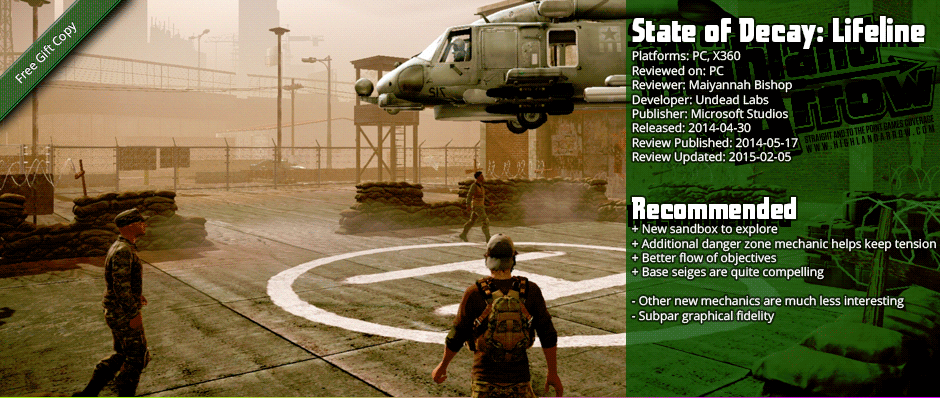

State of Decay: Lifeline is the second DLC for State of Decay by Undead Labs and produced by Microsoft Games. It is not stand-alone and requires State of Decay to play. You can read our original review of the base game here. Lifeline, while it has its own problems, certainly does breath some more life into the game, with much more to offer to the game experience than its predecessor Breakdown, which we reviewed here.
Lifeline builds much better on State of Decay than its predecessor
In retrospect, Breakdown feels like a sort of prototype for Lifeline, a genesis for a lot of the general progression ideas which were then further expanded in Lifeline. The ideas of having to rescue valuable survivors, for example, is front and center in Lifeline, though not as valuable to the player in this iteration. Whereas the "high-value" NPCs to save in Breakdown are a natural sort of high-value because they offer you a generally-speaking much higher-level survivor that you can then subsequently play as, in Lifeline those "high-value" survivors are all NPCs. This ties into the overarching narrative of a military unit staying back in the city proper to save very important civillians, as that's exactly what you're doing. They are civilians who will fight to survive just like before, but you can't play as them - you just take them back to your base and defend them until they can be extracted. From scientists who did work that could unravel what is causing the zombie outbreak to individuals important to the relief efforts, your entire gameplay basically centers around escort quests.

The story is very much a tease in that way, offering what the writers no doubt considered "just enough" to tantalise in way of that exposition, but the fact that it came in such a formulaic manner and didn't offer anything too different from the absolute dearth of zombie games out there lead me to be not all that interested, quite frankly. Coupled with some very undisciplined supposedly-military characters in the plot, and a fair bit of it that is based on contrivance, and I can't say I felt the story was that stellar. It wasn't bad per se - just ... very generic and not very inspired. This plays like Michael Bay tried to make a zombie movie. All flash and no substance, with a particular hard-on for the military.
Base sieges and the danger zones are the meat of the new gameplay
The danger zone mechanic is basically there to reinforce the fact that the city is supposed to be this sort of lost cause that you're valiantly still trying to save people from, though I'd be lying to say if I ever got that feeling from it. Indeed, it seemed more like a difficulty cliff. One moment you'd be basically breezing through a building, courtesy of the experience you have from playing through the base game, and having a constant supply of milspec weapons, just to turn down a wrong alley, or worse yet, a sliver of a building that was mostly safe but had some corner of it arbitrarily within that danger zone and the game will just clown-car zombies on you until you die. You actually stand more chance of getting out of that situation alive if you're alone, paradoxically, because the AI hasn't really improved in much of an appreciable way from the base game, and making the AI more likely to use guns has been a change that only ensures bringing successively more zombies into your location. Getting more than ankle-deep in one of these zones with companions in tow is at the very best an exceedingly frustrating experience, and usually ended in me just leaving them to die as a result of their own stupidity. Even taking that choice was difficult, since more often than not they'd try to follow you and just drag that whole conga line of zombies with you, with all the usual troubles of trying to disengage from combat the base game had. The net effect is that the sandbox is made aggressively small, since more than half of the map is engulfed in this danger zone. The number of houses you can explore is much lower than the base game's setting, and likewise, the sandbox is effectively much smaller. What is meant to create tension and a feeling of danger just feels more like the game curb-stomping you for playing outside of the designated playing area, and effectively kills any desire I had to explore this new setting and see what story it's fluff content had to tell.
Base sieges, on the other hand, were a much meatier and exciting affair. Every time the helicopter comes to pick up survivors and drop off critical supplies this draws out veritable waves of zombies, and the number of waves increases as you play. With base defenses you can now build including mines, distracting fireworks, and the like, and the later game waves including scores of the special zombies against your military forces, this is when Lifeline shines. It's very tense, very fast-paced, and rewards both strategic forethought and tactical in-the-moment planning. With the difficulty of the sieges steadily increasing as you play (and you can keep playing well beyond story completion until you decide you're done or the unit gets wiped out), this is effectively where the truly compelling challenge of Lifeline offers. Again this seems like a refinement of Breakdown, where "how long you can survive" has become something much more valuable for the increasing difficulty of the sieges. The one complaint I'd have about the sieges is this really makes the lack of enemy variety in the game quite obvious, and Lifeline offers nothing new in that respect.



